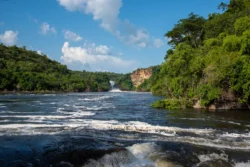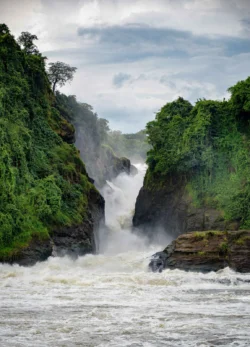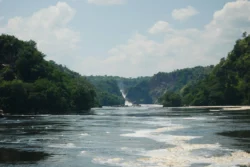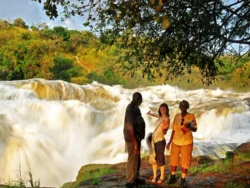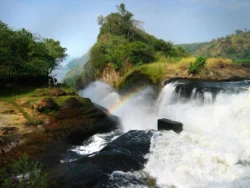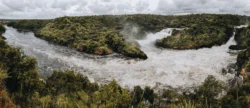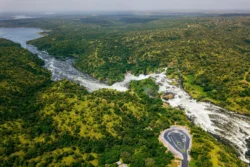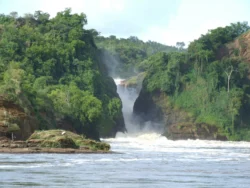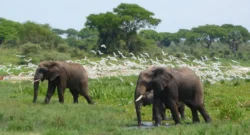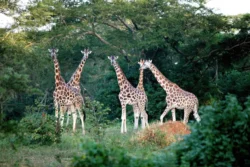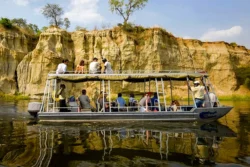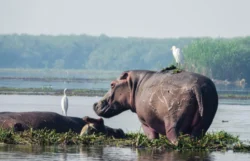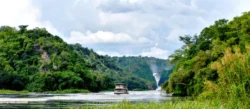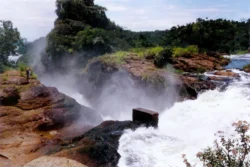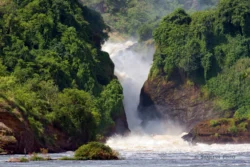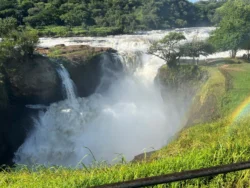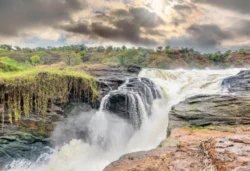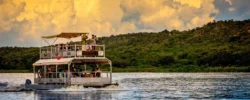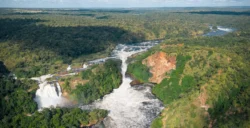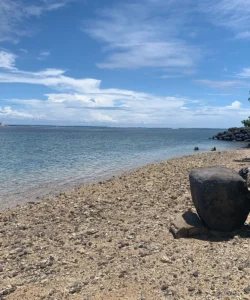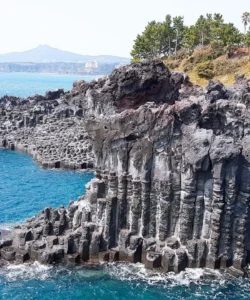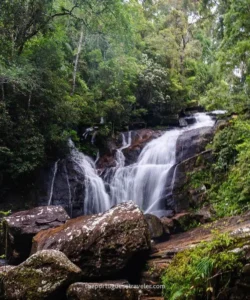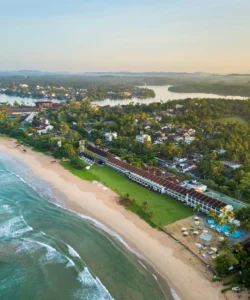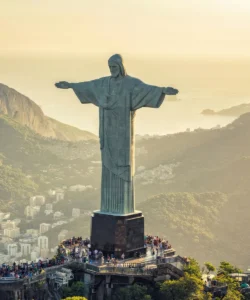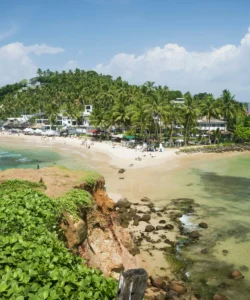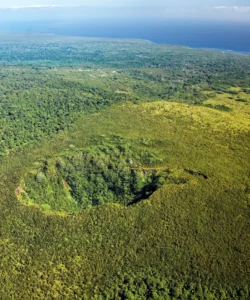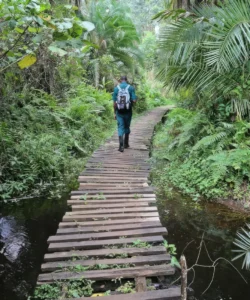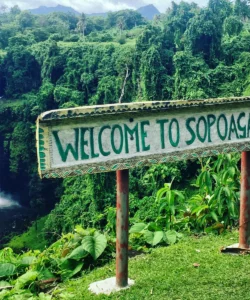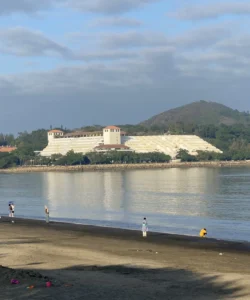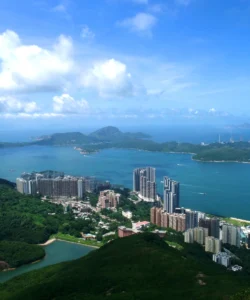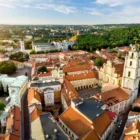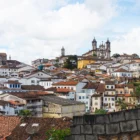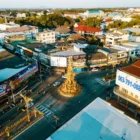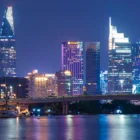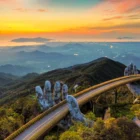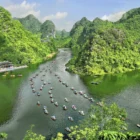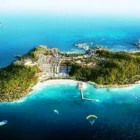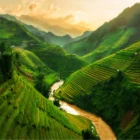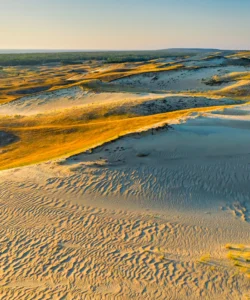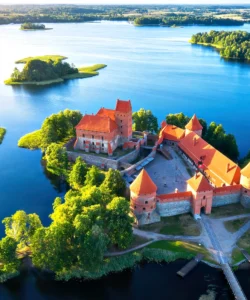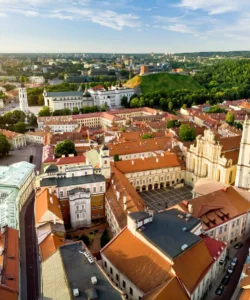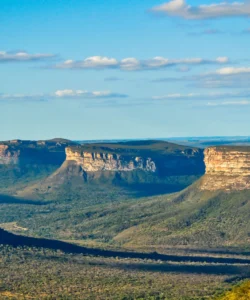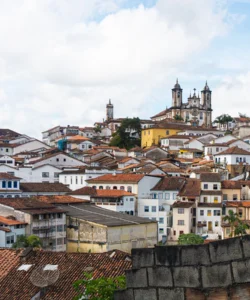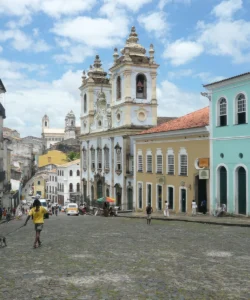Murchison Falls National Park is Uganda’s largest and oldest national park, located in the northwestern part of the country. Named after the powerful Murchison Falls, where the mighty Victoria Nile River dramatically squeezes through a narrow gorge before plunging 43 meters, the park is a land of diverse landscapes and abundant wildlife. It offers a classic East African safari experience, renowned for its incredible concentration of animals, spectacular waterfalls, and thrilling boat cruises on the Nile.
Name: Murchison Falls National Park (also historically known as Kabalega National Park)
Address: Northwestern Uganda. The park straddles the Ugandan districts of Buliisa, Nwoya, Kiryandongo, and Masindi. The main approach from the south is via Masindi district, while northern gates are accessible from the Kampala-Gulu road.
How to get there:
Reaching Murchison Falls National Park, involves a significant international journey followed by domestic travel within Uganda:
- From Entebbe/Kampala (Uganda) to Murchison Falls National Park:
- By Road (Most Common Safari Option): The park is approximately 305 km (190 miles) northwest of Kampala. The drive takes around 4-6 hours, depending on the specific gate and road conditions. Safari operators usually arrange pick-up from Entebbe/Kampala and all further transportation in a 4×4 safari vehicle as part of your package.
- Southern Gates (closer to Masindi): Kichumbanyobo Gate (235 km from Kampala) and Bugungu Gate. These are common for lodges south of the Nile.
- Northern Gates (across the Nile): Chobe Gate, Wankwar Gate, Tangi Gate. These involve crossing the Nile via ferry or bridge.
- By Air (Fastest Option): Daily domestic flights depart from Entebbe International Airport or Kajjansi Airfield (near Kampala) to airstrips within or near the park.
- Pakuba Airstrip: Most commonly used, located in the northern sector, near many lodges.
- Chobe Airstrip: For those staying at Chobe Safari Lodge.
- Bugungu Airstrip: In the southern sector.
Flights take less than 1 hour.
- By Road (Most Common Safari Option): The park is approximately 305 km (190 miles) northwest of Kampala. The drive takes around 4-6 hours, depending on the specific gate and road conditions. Safari operators usually arrange pick-up from Entebbe/Kampala and all further transportation in a 4×4 safari vehicle as part of your package.
Best Time to Visit:
Murchison Falls National Park is enjoyable year-round, but the dry seasons (December to February and June to September) are generally considered the best time to visit for game drives. During these months, there’s less rainfall, tracks are drier and more accessible, and animals gather around water sources, making them easier to spot. Birdwatching is also excellent in these periods.
Operating Hours and Entrance Fee:
- Operating Hours: The park is generally open daily from 6:00 AM to 6:00 PM.
- Entrance Fee (for Foreign Non-Residents):
- Adults: US$45 per person per day.
- Children (5-17 years): US$25 per person per day.
- Vehicles (4×4 safari vehicle): US$150 per vehicle per entry.
- Boat Cruise (to the falls): US$30 per person (for a scheduled 2-hour trip).
- Hiking to the Top of the Falls: Additional fees apply, and it’s mandatory to have a UWA guide for certain activities like night game drives.
- Note: Fees are subject to change by the Uganda Wildlife Authority (UWA). It’s always best to check the latest rates before planning your trip.
Landscape and Architecture:
Murchison Falls National Park’s “architecture” is predominantly its vast and varied natural landscape, shaped by the mighty Nile River:
- The Victoria Nile: The park is bisected by the powerful Victoria Nile River, which flows through it for about 115 km (71 miles) from east to west. The river is the lifeblood of the park and its central feature.
- Murchison Falls: The park’s namesake and dramatic centerpiece. Here, the entire volume of the Victoria Nile is forced through an incredibly narrow gorge, just 7-8 meters (23-26 feet) wide, before plunging 43 meters (141 feet) down into the “Devil’s Cauldron.” This creates a thunderous roar, a permanent mist with rainbows, and immense pressure, making it the world’s most powerful waterfall.
- Savanna Grasslands: The northern section of the park is dominated by vast, open savanna grasslands dotted with Borassus palms and acacia trees, providing excellent visibility for game drives.
- Woodlands and Forests: The southern part of the park features more woodlands and forest patches, including the significant Budongo Forest Reserve (home to chimpanzees) and the smaller Rabongo Forest.
- Riverine Forest and Swamps: Along the Nile and around its delta with Lake Albert, lush riverine forests and extensive papyrus swamps provide unique habitats, particularly for birdlife.
- Lake Albert: The western boundary of the park extends to the shores of Lake Albert, where the Victoria Nile eventually flows.
- Delta Area: Where the Victoria Nile enters Lake Albert, forming a wide, marshy delta rich in birdlife, including the rare shoebill stork.
- Safari Tracks: The park is crisscrossed by unpaved game drive tracks, allowing visitors to explore the various zones.
- Simple Tourist Lodges/Camps: Accommodation within and around the park includes various lodges and tented camps, ranging from budget to luxury, designed to blend with the natural environment. These are the primary “architectural” structures for visitors.
What makes it famous:
Murchison Falls National Park is famous for:
- The World’s Most Powerful Waterfall: The sheer force and dramatic constriction of the Nile River at Murchison Falls are unparalleled, creating a breathtaking natural spectacle.
- Classic Big Game Safaris: It is one of Uganda’s premier destinations for game drives, offering excellent sightings of large mammals including elephants, buffalo, Rothschild’s giraffes (a unique subspecies, present in high numbers), Uganda kobs, Jackson’s hartebeest, oribis, and often lions and leopards.
- Thrilling Boat Cruises on the Nile: A highlight of any visit is the launch trip upstream to the base of Murchison Falls, passing abundant hippos, crocodiles, and diverse birdlife. A downstream cruise to the Nile-Albert Delta is also popular for birdwatching, especially for the elusive shoebill stork.
- Chimpanzee Tracking (Budongo Forest): The southern part of the park includes access to Budongo Forest, one of the best places in Uganda for chimpanzee trekking, offering encounters with these intelligent primates.
- Birdwatcher’s Paradise: With over 450 bird species, including numerous waterbirds and savannah species, it’s a top destination for birding enthusiasts.
- Historical Significance: The park has hosted notable visitors like Winston Churchill, Theodore Roosevelt, and Ernest Hemingway, and the 1951 film “The African Queen” was filmed on Lake Albert and the Nile in the park.
- Ziwa Rhino Sanctuary (Nearby): While rhinos are not in the park, the Ziwa Rhino Sanctuary (located en route to Murchison Falls from Kampala) is Uganda’s only rhino sanctuary, offering a chance to see white rhinos, completing the “Big Five” experience for many safari-goers.
Differences from some other wonders:
Murchison Falls National Park distinguishes itself from other national parks and natural wonders in several key ways:
- River Nile as Central Feature: While other parks might have rivers, the mighty Victoria Nile River bisecting the park and forming the world’s most powerful waterfall is the central, defining geological and ecological feature, influencing the landscape and wildlife viewing opportunities in a unique way (e.g., game drives combined with river safaris). This direct interaction with the legendary Nile River is distinct.
- Dual Safari Experience (Land and Water): Unlike parks that focus solely on land-based game drives, Murchison offers a seamless and highly rewarding combination of land-based game drives and unique boat safaris on the Nile, providing diverse perspectives on its wildlife and landscapes.
- Power of the Falls: The sheer auditory and visual power of Murchison Falls itself – the immense volume of water forced through a tiny gorge – creates a dramatic natural spectacle that is often described as unmatched in East Africa.
- Rothschild’s Giraffe Population: It is one of the best places to see the rare Rothschild’s giraffe (a distinct subspecies) in high numbers, a specific draw for wildlife enthusiasts.
- Integration with Chimpanzee Trekking: The combination of traditional savannah safaris with the opportunity for chimpanzee trekking in the adjacent Budongo Forest offers a broader primate experience than many other African safari parks.
- Accessibility for a Diverse Safari: Murchison Falls provides a comprehensive safari experience that can be relatively easily integrated into a broader Uganda itinerary, including gorilla trekking in Bwindi, making it a versatile hub for diverse wildlife adventures.
In essence, Murchison Falls National Park is a powerful and dynamic wonder, a testament to Uganda’s abundant wildlife and the raw force of nature, offering an unforgettable blend of dramatic landscapes, incredible animal encounters, and unique riverine adventures.

